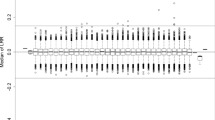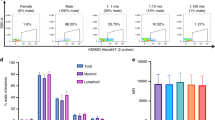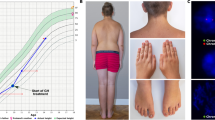Abstract
Analysis of hematopoietic chimerism is important for monitoring engraftment, graft failure, and disease recurrence. Although several techniques are now available, their sensitivity is unsatisfactory. In sex-mismatched stem cell transplantation (SCT) with a female donor, Y chromosome-specific sequences have proven the most sensitive marker. However, in the case of a male donor, no such reliable marker has been available to date. In this study, we report a novel method we developed to detect microchimerism in female recipients who receive SCT from male donors. The X-linked human androgen receptor gene (HUMARA) contains a highly polymorphic CAG trinucleotide repeat. Near this polymorphic site are methyl-sensitive HpaII restriction enzyme sites. After HpaII digestion, unmethylated male HUMARA sequences are completely digested, while methylated female ones remain intact among the male origin cells. This allows a highly efficient detection of a small number of female cells. Combined with the nested PCR technique, the X chromosome methylation-based chimerism assay could attain a 10−4 level of sensitivity, which is 1000-fold higher than that of conventional assays. The applicability of the method was confirmed in two transplant cases. This highly sensitive method can also be applied to detect minimal residual disease or microchimerism in conditions other than hematopoietic SCT. Bone Marrow Transplantation (2001) 28, 969–973.
This is a preview of subscription content, access via your institution
Access options
Subscribe to this journal
Receive 12 print issues and online access
$259.00 per year
only $21.58 per issue
Buy this article
- Purchase on Springer Link
- Instant access to full article PDF
Prices may be subject to local taxes which are calculated during checkout



Similar content being viewed by others
References
Ugozzoli L, Yam P, Petz LD et al. Amplification by the polymerase chain reaction of hypervariable regions of the human genome for evaluation of chimerism after bone marrow transplantation Blood 1991 77: 1607–1615
van Leeuwen JE, van Tol MJ, Bodzinga BG et al. Detection of mixed chimaerism in flow-sorted cell subpopulations by PCR-amplified VNTR markers after allogeneic bone marrow transplantation Br J Haematol 1991 79: 218–225
Edwards A, Hammond H, Jin L et al. Genetic variation at five trimeric and tetrameric tandem repeat loci in four human population groups Genomics 1992 12: 241–253
Mackinnon S, Barnett L, Bourhis J et al. Myeloid and lymphoid chimerism after T-cell-depleted bone marrow transplantation: evaluation of conditioning regimens using the polymerase chain reaction to amplify human minisatellite regions of genomic DNA Blood 1992 80: 3235–3241
Leclair B, Fregeau CJ, Aye MT, Fourney RM . DNA typing for bone marrow engraftment follow-up after allogeneic transplant: a comparative study of current technologies Bone Marrow Transplant 1995 16: 43–55
Tilley WD, Marcelli M, Wilson JD, McPhaul MJ . Characterization and expression of a cDNA encoding the human androgen receptor Proc Natl Acad Sci USA 1989 86: 327–331
Allen RC, Zoghbi HY, Moseley AB et al. Methylation of HpaII and HhaI sites near the polymorphic CAG repeat in the human androgen-receptor gene correlates with X chromosome inactivation Am J Hum Genet 1992 51: 1229–1239
Fialkow PJ . Use of genetic markers to study cellular origin and development of tumors in human females Adv Cancer Res 1972 15: 191–226
Vogelstein B, Fearon ER, Hamilton SR et al. Clonal analysis using recombinant DNA probes from the X-chromosome Cancer Res 1987 47: 4806–4813
Willman CL, Busque L, Griffith BB et al. Langerhans’-cell histiocytosis (histiocytosis X): a clonal proliferative disease New Engl J Med 1994 331: 154–160
Anan K, Ito M, Misawa M et al. Clonal analysis of peripheral blood and haemopoietic colonies in patients with aplastic anaemia and refractory anaemia using the polymorphic short tandem repeat on the human androgen-receptor (HUMARA) gene Br J Haematol 1995 91: 838–845
Wessman M, Ruutu T, Volin L, Knuutila S . In situ hybridization using a Y-specific probe – a sensitive method for distinguishing residual male recipient cells from female donor cells in bone marrow transplantation Bone Marrow Transplant 1989 4: 283–286
Durnam D, Anders K, Fisher L et al. Analysis of the origin of marrow cells in bone marrow transplant recipients using a Y-chromosome-specific in situ hybridization assay Blood 1989 74: 2220–2226
Viard F, Merel P, Bilhou Nabera C et al. Mixed chimerism after sex-mismatched allogeneic BMT: evaluation of two molecular techniques Bone Marrow Transplant 1993 11: 27–31
Karasawa M, Tsukamoto N, Yamane A et al. Distribution of CAG repeats and X-chromosome inactivation status of HUMARA gene in normal females Int J Hematol 2001 74: 281–286
Mutter GL, Boynton KA . PCR bias in amplification of androgen receptor alleles, a trinucleotide repeat marker used in clonality studies Nucleic Acids Res 1995 23: 1411–1418
Thiede C, Florek M, Bornhauser M et al. Rapid quantification of mixed chimerism using multiplex amplification of short tandem repeat markers and fluorescence detection Bone Marrow Transplant 1999 23: 1055–1060
Pindolia K, Janakiraman N, Kasten-Sportes C et al. Enhanced assessment of allogeneic bone marrow transplant engraftment using automated fluorescent-based typing Bone Marrow Transplant 1999 24: 1235–1241
Gale RE, Mein CA, Linch DC . Quantification of X-chromosome inactivation patterns in haematological samples using the DNA PCR-based HUMARA assay Leukemia 1996 10: 362–367
Busque L, Mio R, Mattioli J et al. Nonrandom X-inactivation patterns in normal females: lyonization ratios vary with age Blood 1996 88: 59–65
Gale RE, Fielding AK, Harrison CN, Linch DC . Acquired skewing of X-chromosome inactivation patterns in myeloid cells of the elderly suggests stochastic clonal loss with age Br J Haematol 1997 98: 512–519
Bertheas MF, Lafage M, Levy P et al. Influence of mixed chimerism on the results of allogeneic bone marrow transplantation for leukemia Blood 1991 78: 3103–3106
Colson YL, Lange J, Fowler K, Ildstad ST . Mechanism for cotolerance in nonlethally conditioned mixed chimeras: negative selection of the Vbeta T-cell receptor repertoire by both host and donor bone marrow-derived cells Blood 1996 88: 4601–4610
Childs R, Clave E, Contentin N et al. Engraftment kinetics after nonmyeloablative allogeneic peripheral blood stem cell transplantation: full donor T-cell chimerism precedes alloimmune responses Blood 1999 94: 3234–3241
Starzl TE, Demetris AJ, Murase N et al. Cell migration, chimerism, and graft acceptance Lancet 1992 339: 1579–1582
Artlett CM, Smith JB, Jimenez SA . Identification of fetal DNA and cells in skin lesions from women with systemic sclerosis New Engl J Med 1998 338: 1186–1191
Nelson JL, Furst DE, Maloney S et al. Microchimerism and HLA-compatible relationships of pregnancy in scleroderma Lancet 1998 351: 559–562
Maloney S, Smith A, Furst DE et al. Microchimerism of maternal origin persists into adult life J Clin Invest 1999 104: 41–47
Acknowledgements
The authors would like to thank to Drs Y Tanaka, S Takada, T Kawamura, Y Tsumita, N Hatsumi, T Matsushima, T Sakura and S Miyawaki for providing patients' samples, and Drs J Isoda, H Koiso, A Yokohama and H Murakami for valuable help and advice. This study was supported in part by a grant from the Intractable Disease Committee of the Ministry of Health and Welfare of Japan.
Author information
Authors and Affiliations
Rights and permissions
About this article
Cite this article
Yamane, A., Karasawa, M., Maehara, T. et al. X chromosome methylation-based chimerism assay for sex-mismatched hematopoietic stem cell transplantation. Bone Marrow Transplant 28, 969–973 (2001). https://doi.org/10.1038/sj.bmt.1703275
Received:
Accepted:
Published:
Issue Date:
DOI: https://doi.org/10.1038/sj.bmt.1703275
Keywords
This article is cited by
-
Beyond chimerism analysis: methods for tracking a new generation of cell-based medicines
Bone Marrow Transplantation (2020)



